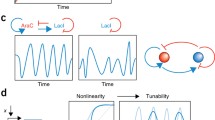Abstract
The NO + Fe2+ + thiols system in an aqueous solution has been found earlier to exhibit temporal oscillatory changes in the concentration of paramagnetic dinitrosyl iron complexes with thiol-containing ligands and S-nitrosothiols, as well as in the concentration of free iron (not included in the complexes). It is proposed that autowaves can appear in this system characterized by periodic changes in the concentrations of its components in time and space. Such changes may form a basis for the control of the physiological effects of nitric oxide, dinitrosyl iron complexes, and S-nitrosothiols as agents affecting various cellular and tissue targets.
Similar content being viewed by others
References
L. J. Ignarro, Nitric Oxide: Biology and Pharmacology (San Diego, Academic Press, 2000).
D. Wenderhenne, A. Pugin, D. F. Klessig, and J. Durner, Trends Plant Sci. 6, 177 (2001).
W. Zumft, Microbiol. Mol. Biol. Rev. 61, 533 (1997).
W. P. Arnold, C. K. Mittal, S. Katsuki, and F. Murad, Proc. Natl. Acad. Sci. USA 74, 3203 (1977).
D. F. Wilson, M. Erecinska, and C. S. Owen, Arch. Biochem. Biophys. 175, 160 (1976).
R. E. Ebel, D. H. O’Keefe, and J. A. Peterson, FEBS Lett. 55, 198 (1975).
Y. Henry and R. Banerjee, J. Mol. Biol., 73, 469 (1973).
C. L. Walters and A. M. Taylor, Biochim. Biophys. Acta 82, 420 (1964).
J. S. Stamler, Cell 78, 931 (1994).
M. W. Foster and J. S. Stamler, J. Biol. Chem. 279, 25891 (2004).
A. F. Vanin, I. V. Malenkova, P. I. Mordvintsev, and A. Muelsch, Biokhimiya 58, 1094 (1993).
M. Boese, P. I. Mordvintsev, A. F. Vanin, et al., J. Biol. Chem. 270, 29249 (1995).
A. F. Vanin and I. V. Malenkova, Biokhimiya 61, 374 (1996).
A. F. Vanin, I. V. Malenkova, and V. A. Serezhenkov, Nitric Oxide: Biol. Chem. 1, 191 (1997).
A. F. Vanin, A. A. Papina, V. A. Serezhenkov, and W. H. Koppenol, Nitric Oxide: Biol. Chem. 10, 60 (2004).
Author information
Authors and Affiliations
Additional information
Original Russian Text © A.F. Vanin, 2006, published in Biofizika, 2006, Vol. 51, No. 6, pp. 965–967.
Rights and permissions
About this article
Cite this article
Vanin, A.F. Autowave mode of the functioning of the nitric oxide + free iron + thiols system as a basis for control of the biological action of nitric oxide and its endogenous compounds. BIOPHYSICS 51, 851–852 (2006). https://doi.org/10.1134/S0006350906060017
Received:
Issue Date:
DOI: https://doi.org/10.1134/S0006350906060017



